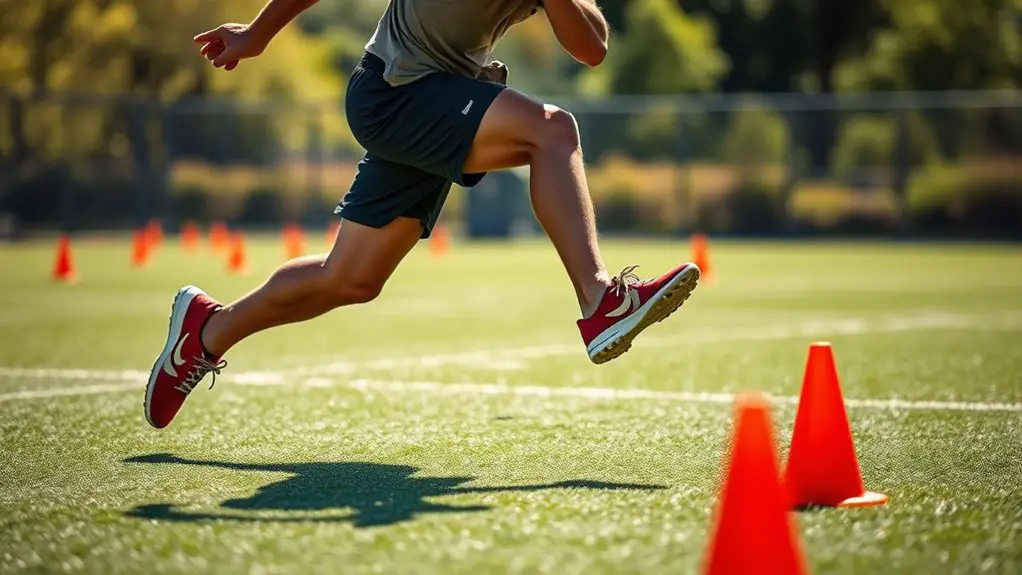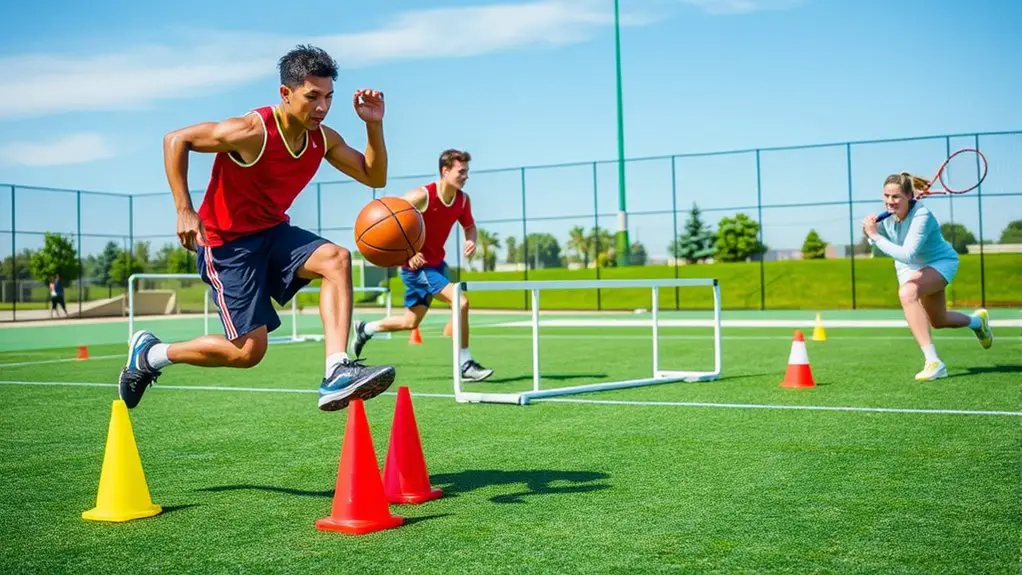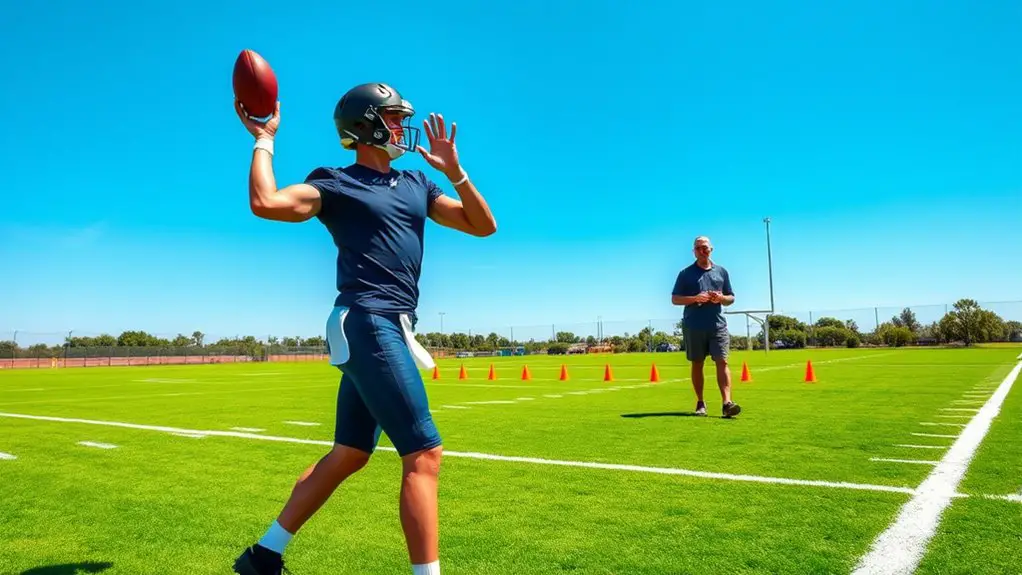To train for explosive change-of-direction speed, focus on agility, strength, and power through specific drills. Incorporate agility ladder and cone drills to sharpen your footwork and quickness. Strength training, like squats and deadlifts, will build your muscle power, while plyometric exercises such as box jumps and lateral bounds enhance explosive movements. Don't forget to monitor your progress and adjust your training for best results. There's much more you can explore to elevate your performance further.
Understanding the Importance of Change-of-Direction Speed
When you think about speed, it's easy to focus solely on straight-line sprints; however, mastering change-of-direction speed is just as vital for overall performance. The importance of agility can't be overstated, especially if you want to break free from the confines of traditional training. When you can pivot, accelerate, and decelerate efficiently, you're not just fast—you're dynamic.
Understanding change of direction mechanics is significant. It's about more than just physical ability; it's about being aware of your body's movements and how they interact with the ground. Proper mechanics allow you to harness your energy effectively, letting you change direction swiftly while minimizing the risk of injury. Incorporating agility ladder drills into your training routine can enhance your overall agility and coordination.
Key Components of Explosive Speed Training
To boost your explosive speed, it's vital to focus on key components like strength and power development, agility drills, and proper warm-up protocols. Each element plays a significant role in enhancing your overall performance. Let's break down how these components work together to elevate your speed training. Additionally, incorporating plyometric exercises into your routine can significantly improve your explosive power and agility.
Strength and Power Development
Strength and power development are essential elements in enhancing explosive speed. To achieve this, you need a solid foundation in strength training. Building muscle strength not only supports your overall performance but also boosts your power output during quick direction changes. Focus on compound exercises like squats and deadlifts, which engage multiple muscle groups and mimic the demands of explosive movements. Incorporating plyometrics can further elevate your training, as they enhance your ability to generate force rapidly. Remember, the goal is to cultivate both strength and explosive power, allowing you to move freely and swiftly. By prioritizing these components, you'll reveal your potential and experience a noticeable improvement in your speed and agility on the field.
Agility Drills and Techniques
Agility drills are essential for enhancing your explosive speed and overall athletic performance. Incorporating agility cones, lateral hurdles, and an agility ladder into your routine will sharpen your quick feet and improve movement efficiency. Focus on various footwork patterns to build agility and speed during directional changes. Reaction drills can be particularly beneficial, as they challenge your ability to adapt and respond swiftly. The combination of these drills not only develops your physical capabilities but also cultivates a sense of freedom in your movements. By mastering these techniques, you'll be able to navigate the field or court with ease, leaving opponents behind as you explode into action and showcase your agility. Get ready to elevate your game!
Proper Warm-Up Protocols
A solid warm-up is essential for optimizing your performance and reducing the risk of injury during speed training. To get your body ready for explosive movements, focus on these key components:
- Dynamic stretching: Incorporate movements like leg swings and arm circles to increase blood flow.
- Mobility exercises: Prioritize hip and ankle mobility to enhance your range of motion.
- Activation drills: Engage your core and glutes with exercises like bridges and clamshells.
- Progressive intensity: Gradually increase your speed during drills to prepare your muscles for explosive efforts.
Essential Drills for Enhancing Agility
Improving your agility is essential for enhancing overall speed and performance in any sport. To kick things off, agility cones are a fantastic tool for developing quick lateral movement and refining your footwork patterns. Set them up in various formations and practice weaving in and out, focusing on your reaction time and changing directions swiftly.
Ladder drills are another must-do. They'll help you sharpen your sprint mechanics while building coordination and speed. Incorporate different footwork patterns to keep things fresh and challenging.
Don't forget about balance training! Use single-leg exercises to cultivate stability, which is vital for explosive movements. Additionally, integrating strength training into your routine can significantly enhance your power for directional changes.
Lastly, incorporate visual cues like a partner or coach signaling directions, pushing your agility to the next level. By consistently practicing these drills, you'll feel the freedom of enhanced agility, empowering you to perform at your best on the field or court.
Strength Training Exercises to Boost Performance
While speed and agility are essential, strength training plays an equally important role in boosting your overall performance. By incorporating specific exercises, you can enhance your strength, leading to better change-of-direction speed. Here are some key strength training exercises to reflect on:
- Squats: Build lower body strength and stability.
- Deadlifts: Engage multiple muscle groups for overall power.
- Lunges: Improve balance and unilateral strength.
- Bench Press: Strengthen your upper body for better control.
Focusing on these exercises can lead to significant performance enhancement, allowing you to change direction explosively and efficiently. Remember, it's not just about speed; having a solid foundation of strength will give you the freedom to move with agility and confidence. Embrace strength training as a crucial part of your routine, and you'll notice the difference in your athletic performance. Additionally, incorporating Olympic lifts can further elevate your training by boosting explosive strength and coordination.
Incorporating Plyometrics for Explosive Power
If you want to boost your speed, incorporating plyometrics can be a game changer. These explosive movements not only enhance your power but also improve your overall performance. Let's explore the benefits of plyometric training and some key exercises you can start with. Additionally, plyometrics focus on the stretch-shortening cycle of muscles, which is essential for maximizing explosive strength.
Benefits of Plyometric Training
Plyometric training is a powerful tool for athletes looking to boost their explosive power and speed. By incorporating plyometrics into your routine, you can experience numerous benefits that enhance your athletic performance:
- Increased Muscle Strength: Builds strength in key muscle groups, allowing for more forceful movements.
- Improved Reaction Time: Enhances your ability to respond quickly during dynamic activities.
- Enhanced Coordination: Develops better body control and agility, essential for change-of-direction speed.
- Greater Endurance: Increases stamina, helping you maintain high-intensity efforts for longer periods.
These plyometric benefits not only elevate your performance but also provide a sense of freedom in your athletic pursuits. Embrace the challenge and release your potential!
Key Plyometric Exercises
Building on the benefits of plyometric training, incorporating specific exercises into your routine can considerably enhance your explosive power. Start with box jumps, which engage your legs and core while promoting powerful upward movements. Add in depth jumps to improve your reactive strength—land softly and spring back up for maximum effect. Incorporating plyometric variations like lateral bounds and single-leg hops can boost your agility, allowing for quicker change-of-direction. Don't forget burpees; they combine multiple explosive movements, enhancing your overall athleticism. As you progress, focus on explosive movements that mimic your sport's demands, ensuring you're agile and ready for anything. With consistent practice, you'll feel the freedom of effortless speed and agility in your performance.
Monitoring Progress and Making Adjustments
Monitoring your progress and making adjustments is essential in any speed training regimen. You want to guarantee you're not just putting in the work but also seeing the results you crave. Implementing effective progress tracking and adjustment strategies will keep you on the right path. Here are some tips to help you out:
Monitoring your progress and adjusting your training is vital for achieving the results you desire. Stay on track with effective strategies.
- Record your performance: Keep a journal of your workouts and results, noting areas of improvement.
- Evaluate your goals: Regularly check if your targets align with your current abilities and adjust them as needed.
- Listen to your body: Be mindful of fatigue or injury; modify your training intensity or frequency accordingly.
- Seek feedback: Work with a coach or a peer who can provide insights on your technique and progress.
- Incorporating mindfulness practices can also help you stay focused and present during your training sessions.
Frequently Asked Questions
How Often Should I Train for Change-Of-Direction Speed?
Training for change-of-direction speed is like fine-tuning a race car; you need the right frequency of sessions to hit peak performance. Aim for two to three ideal sessions per week, allowing your body time to recover and adapt. This balance lets you break free from limitations while enhancing your agility. Listen to your body and adjust as needed, ensuring every training moment fuels your progress without burnout.
What Age Is Appropriate to Start Training Agility?
You can start training agility at a young age, typically around 6 to 8 years old. Youth training should focus on fun and engaging agility drills that develop coordination and balance rather than intense conditioning. This approach fosters a love for movement and helps kids build foundational skills. As they grow, you can gradually introduce more complex drills, allowing them to explore their physical potential while enjoying the freedom of movement.
Can Bodyweight Exercises Improve Change-Of-Direction Speed?
Bodyweight benefits bring boundless potential for improving your change-of-direction speed. By incorporating explosive training with exercises like jumps, lunges, and sprints, you can enhance your agility and reaction time. These dynamic movements help build strength and stability, allowing you to shift directions swiftly and smoothly. Embrace the freedom of movement, and you'll notice significant improvements in your performance. So, get moving and enjoy the journey to becoming quicker and more agile!
Is Nutrition Important for Agility Training?
Absolutely, nutrition's essential for agility training. You need to focus on nutrition timing to fuel your workouts effectively. Eating the right foods before and after training can enhance your performance and recovery. Don't forget hydration strategies, too; staying properly hydrated helps maintain your energy levels and prevents fatigue. When you prioritize your nutrition and hydration, you're giving yourself the freedom to push your limits and improve your agility skills.
How Do I Prevent Injuries While Training Agility?
To prevent injuries while training agility, you should focus on injury prevention techniques. Always start with warm-up routines that include dynamic stretches and mobility exercises. This helps prepare your muscles and joints for the intense movements ahead. Pay attention to your body's signals—if something feels off, take a break. Gradually increase the intensity of your workouts, and consider incorporating strength training to support your agility goals. Freedom in movement comes from being smart about your training!




